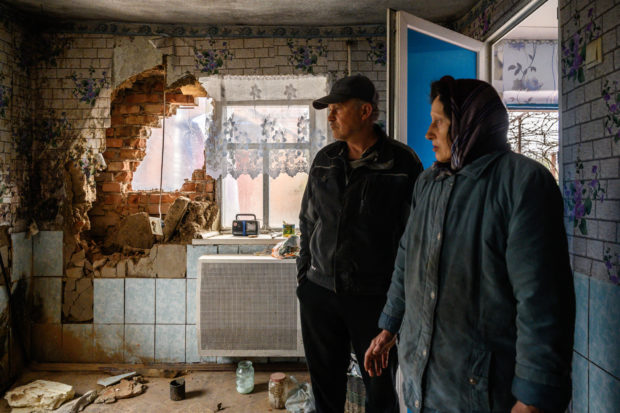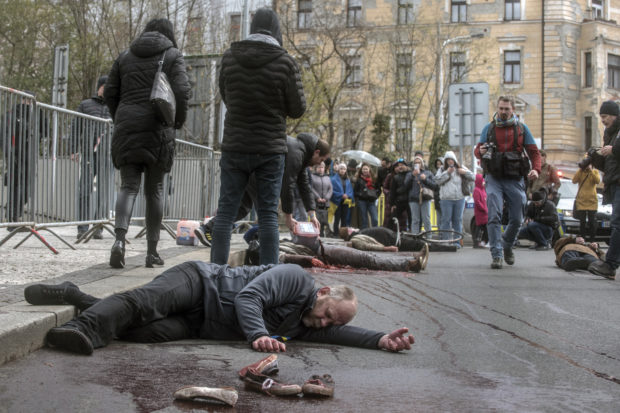‘Terrible toll’: Russia’s invasion of Ukraine in numbers

Tanya Los (R), 57, and her husband Valery, stand in their house near damage caused by a rocket which landed on April 17, and is understood to have been launched from a Soviet-era BM-27 Uragan launcher based on serial numbers seen on the wreckage by AFP, in the village of Mala Tomachka, near the southern front of fighting between Ukrainian and Russian forces, south of Zaporizhzhia, on April 19, 2022. AFP FILE PHOTO
PARIS — When Russia’s President Vladimir Putin ordered the invasion of Ukraine on February 24, 2022, he started a war that has killed tens of thousands of people, ravaged cities and pummeled the country’s economy.
A year on, here is the cost of the conflict:
Military losses
According to the latest estimates from Norway, 180,000 Russian soldiers and 100,000 Ukrainian troops have been wounded or killed in the conflict.
Other Western sources estimate the war has caused 150,000 casualties on each side.
In comparison, some 15,000 Soviet soldiers were killed in a whole decade of fighting in Afghanistan from 1979 to 1989.
Article continues after this advertisementUkrainian soldiers often use the term “cannon fodder” to describe the Russians sent to their death along the front line.
Article continues after this advertisementThey are often poorly trained conscripts who stand little chance against Ukrainian forces determined to defend their country.
Others are convicts recruited in Russian jails to swell the ranks of Russian paramilitary group Wagner, who Kyiv and its allies say are deployed on near-impossible missions with the equivalent of a gun pointed to their head.
The onslaught has also taken its toll on the Ukrainian side, as shown by the endless blue and yellow national flags fluttering above cemeteries across the embattled country.
Civilian losses
By the time Moscow’s forces seized control of Mariupol in late May after three months of heavy bombardment, the southern port city had been reduced to a sea of rubble strewn with dead bodies.
Kyiv said at least 20,000 Ukrainian civilians had been killed.
In total, some 30,000 to 40,000 civilians have lost their lives nationwide in the conflict, Western sources say.
The United Nations estimates that 21,000 civilians have been killed or wounded in the fighting, but said the real figure was likely much higher.
Ukrainian authorities say at least 400 children have been killed.
The UN said most of the civilians killed lost their lives during Russian bombardment.
Long term, landmines will also be a huge threat to civilians.
Kyiv says 30 percent of Ukrainian territory has been contaminated, while Human Rights Watch accuses Ukrainian troops of having planted banned anti-personnel landmines in the eastern region of Izyum.
Experts warn demining could take decades.

Demonstrators lie on the ground near the Russian Embassy in Prague on April 9, 2022 to commemorate the civilian killings in Bucha, a town north of the Ukrainian capital, where Russian forces are accused by Ukraine’s allies of having carried out atrocities against civilians. AFP
War crimes
Several images have come to symbolize the war’s devastating impact on ordinary Ukrainians.
When AFP journalists entered the Kyiv suburb of Bucha on April 2, 2022, they found one street littered with the bodies of civilians.
One man had fallen onto his bike, another still had a shopping bag in his hand. Yet another had his hands tied behind his back.
Days later, a child’s toy lay bloodied at a train station in the eastern city of Kramatorsk, after a Russian missile hit as thousands of civilians waited for a train to flee the violence. At least 57 civilians were killed.
The previous month, people around the world saw the photograph of a heavily pregnant woman on a stretcher being evacuated from a Mariupol hospital after it was bombed. Neither she nor her baby survived.
Around 65,000 suspected war crimes have been reported throughout the war, the European Union’s justice commissioner Didier Reynders said.
UN investigators have accused Russia of committing war crimes on a “massive scale” in Ukraine — bombings, executions, torture and horrific sexual violence.
Kyiv alleges Moscow has forcibly deported more than 16,000 children to Russia or areas controlled by Moscow-backed separatists.
Several NGOs have condemned Ukraine, meanwhile, for violating the rights of Russian prisoners of war, but on a much smaller scale.
The International Criminal Court launched an investigation into war crimes and crimes against humanity last year.
But it cannot prosecute either country for any possible war crimes since neither Russia nor Ukraine is a member of the Hague-based court.
Kyiv is instead pressing for a special tribunal to be set up to prosecute Moscow for the crime of aggression because it sees this as a way to achieve faster justice and more easily target the Kremlin’s top officials.
1,500-km front line
On the eastern battlefront, entire villages and towns lie in ruins, and the earth is dotted with huge craters.
Exhausted soldiers lie in wait at the bottom of muddy trenches, while the dull thud of artillery fire booms overhead.
The “active” front line runs north to south along 1,500 kilometers (900 miles) of territory, according to Valery Zaluzhny, the commander in chief of Ukraine’s armed forces.
Among the hotspots is the town of Bakhmut, dubbed “hell on earth” by many Ukrainian soldiers, where Russian soldiers and Wagner mercenaries have been steadily inching forward in recent weeks.
A few thousand civilians still live in the town, hunkering in cellars without running water or electricity, taking great risks when they venture out for fresh air, food, water and fuel.
Moscow’s troops occupy almost a fifth of Ukraine, according to figures from the US-based Institute for the Study of War.
But Zaluzhny said Ukrainian forces had managed to wrest back some 40 percent of territory occupied after the invasion last year.
Battered economy
Fighting has been concentrated in the east of Ukraine since Russian forces withdrew from the north of the country a month into the war, following their failure to capture Kyiv.
In these areas, homes, businesses and factories have been ravaged.
Nationwide, Russia has repeatedly targeted key energy infrastructure in recent months, causing blackouts and leaving millions without heating this winter.
The World Bank in October said it expected the country’s economy to contract by 35 percent in 2022.
The Kyiv School of Economics in January estimated it would cost $138 billion to replace all the infrastructure ravaged by war.
In a country famed for its cereal and sunflower oil exports, the war has caused more than $34 billion in economic losses in the agricultural sector, it said in November.
Some 3,000 schools have been affected by the fighting, the Ukrainian government said, as well as 239 cultural sites, according to the UN cultural fund.
Rebuilding Ukraine following the invasion would cost an estimated $349 billion, a joint assessment by the Ukrainian government, the European Commission and the World Bank found in September.
“The Russian invasion of Ukraine continues to exact a terrible toll,” the World Bank’s Anna Bjerde said at the time.

This file photo taken on January 6, 2023 shows Ukrainian parents Valerii Titkov (2nd R) and Irina Titkova (R) with their sons Danylo (L) and Denys taking a toast during their Christmas dinner as they celebrated their first Orthodox Christmas in exile, in Vienna, Austria. AFP
Millions of refugees
More than eight million Ukrainians have been forced to flee Ukraine since the war broke out, the UN refugee agency said, the largest refugee crisis in Europe since World War II.
Neighboring Poland hosts the largest share of these refugees, with more than 1.5 million of them.
More than five million people have been displaced inside the country.
Moscow said another five million people had sought refuge in Russia, though Kyiv has accused the Russians of conducting “forced evacuations”.
Western military aid
When Russia invaded, the Ukrainian armed forces mostly had outdated, Soviet-era military equipment to defend themselves.
Kyiv has repeatedly urged its Western allies to send it modern weaponry, from air defense systems to heavy tanks.
The West was initially reluctant to become too involved, in order to avoid any more direct confrontation between it and nuclear-armed Russia, but little by little it has acceded to most demands.
But President Volodymyr Zelensky’s request for F-16 fighter jets has so far gone unmet.
Among the aid, the United States sent Himars precision rocket launchers with a range of 80 km (50 miles), far superior to that of Russian equipment, that analysts say helped turn the tide this autumn in the battle against the Russians in the Kharkiv region in the northeast and Kherson region in the south.
By November, Kyiv’s allies had pledged more than 37 billion euros ($40 billion) in military aid, according to the Kiel Institute for the World Economy.
That figure does not include the latest announcements in January that the US, Canada and several European countries will send Ukraine modern battle tanks.
RELATED STORIES